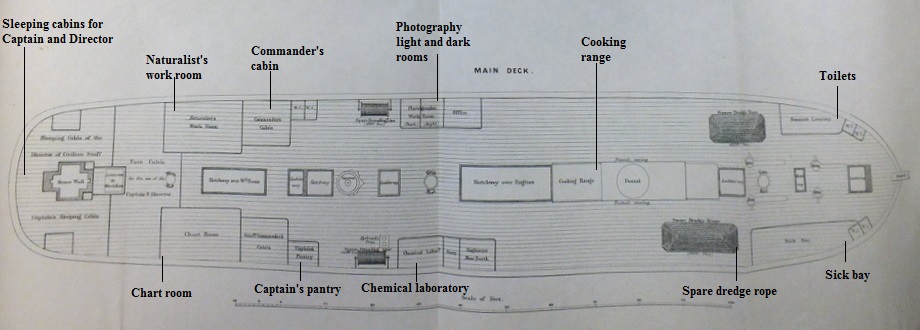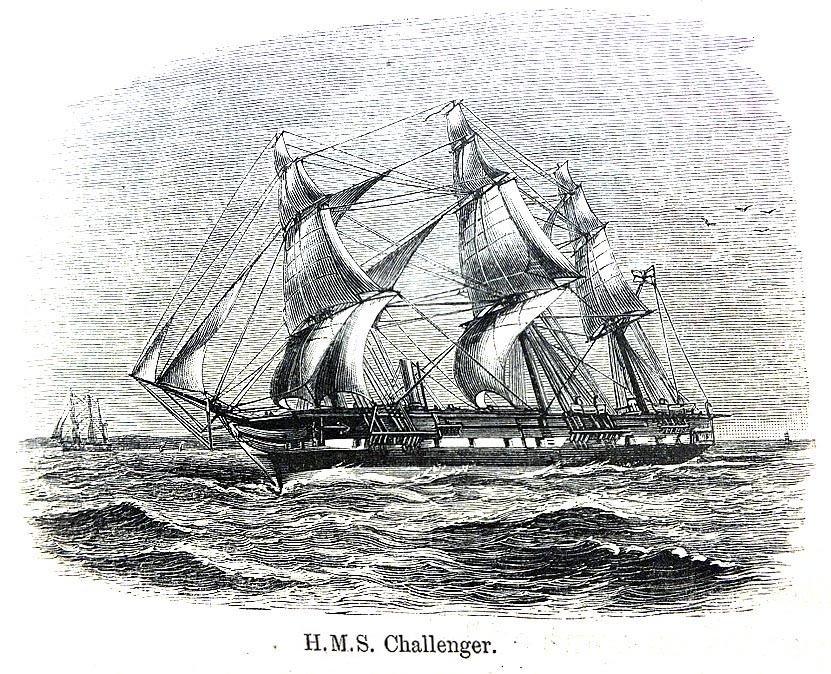The HMS Challenger scientific expedition is fascinating to hear about. For those of you that don’t know much about it and want to know more than what is in the About the Project page then do read on!
Why search for deep-sea life?
Scientists started looking for deep-sea life to challenge Edward Forbes’ ‘azoic’ theory: The idea that life did not exist below 300 fathoms (about 1800 feet or 549 metres). Forbes was professor of Natural History at the University of Edinburgh and a very influential man, so his theory was accepted by many. But not by Charles Wyville Thomson! Thomson worked with his friend William Carpenter to commission the voyage of HMS Lightening that successfully found life at 600 fathoms. This, and the voyages of HMS Porcupine and HMS Shearwater, set the scene for HMS Challenger to explore deep-sea life.
What did HMS Challenger aim to study?
There were four main scientific areas that Wyville Thomson and Carpenter wanted to study:
- The physical conditions of the sea – What was the temperature of the deep sea? The depth? How far would light travel through the water?
- The life in the sea – What life is there? At what depths is there life? How is it spread through different areas?
- The sediments in the sea – What are they and where has it come from?
- The chemistry of the sea – What is the seawater made of? Does it change at different depths?
These questions had never been answered before. The answers could also add support to the theory of evolution if living creatures were discovered that had previously only been found as fossils on land. Just try to even imagine back in time when none of this was known (hard isn’t it?)…this was a huge investigation which meant an awful lot of work!
The ship and the start of the voyage
Let me tell you a little bit about the ship itself. What was it like? Well, the ship itself was a royal Navy vessel launched in 1858. For the expedition, all but two guns were removed from the ship so there was room for storage of equipment, a dark room for photography, cabins for the crew and laboratories to work in (click on the picture above to see a bigger, annotated version of the layout of the main deck – there is also a top deck, lower deck and a hold on the ship). It wasn’t an overly big ship – there was not much room at all for the 269 crew on board (including 6 scientists) who set off from Portsmouth on 21st December 1872.
Annotated main deck plan
 It wasn’t a fantastic start either – with very stormy weather that made the men seasick and struggle to sit down to eat. However, once they left Gibraltar, things started to look up. They found a sea pen. This was great news as they believed that this was evidence to back up Darwin’s theory of evolution as until now these had only been found on land as fossils. The crew now had hope again. Life on board was certainly not lovely and cosy though – the crew had a very tough time. The cabins for the crew to sleep in were small. Some crew members even had to live below decks in a space only big enough for a chair. Most of the seaman at some point of the voyage got a disease called dysentery, where bacteria causes damage to the large intestines, causing dehydration and diarrhoea. Not a pleasant experience! This was no easy voyage.
It wasn’t a fantastic start either – with very stormy weather that made the men seasick and struggle to sit down to eat. However, once they left Gibraltar, things started to look up. They found a sea pen. This was great news as they believed that this was evidence to back up Darwin’s theory of evolution as until now these had only been found on land as fossils. The crew now had hope again. Life on board was certainly not lovely and cosy though – the crew had a very tough time. The cabins for the crew to sleep in were small. Some crew members even had to live below decks in a space only big enough for a chair. Most of the seaman at some point of the voyage got a disease called dysentery, where bacteria causes damage to the large intestines, causing dehydration and diarrhoea. Not a pleasant experience! This was no easy voyage.  I won’t carry on and tell you the whole story right now. The voyage travelled around the globe and will take a long time to tell. So keep an eye out for future posts from myself and the project team where we will continue this fascinating tale of exploration, tell you about the crew the collections of material found, the scientists involved in analysis and more. If there are any particular parts of the voyage you want to know about (or anything else Challenger related for that matter) then do let me know. RAMM has all 50 volumes of the Challenger report (yes, they did take a long time to write – 19 years to publish in fact!) which have a lot of information in. Of course, I will be letting you know all about the progress of the project too!
I won’t carry on and tell you the whole story right now. The voyage travelled around the globe and will take a long time to tell. So keep an eye out for future posts from myself and the project team where we will continue this fascinating tale of exploration, tell you about the crew the collections of material found, the scientists involved in analysis and more. If there are any particular parts of the voyage you want to know about (or anything else Challenger related for that matter) then do let me know. RAMM has all 50 volumes of the Challenger report (yes, they did take a long time to write – 19 years to publish in fact!) which have a lot of information in. Of course, I will be letting you know all about the progress of the project too!
